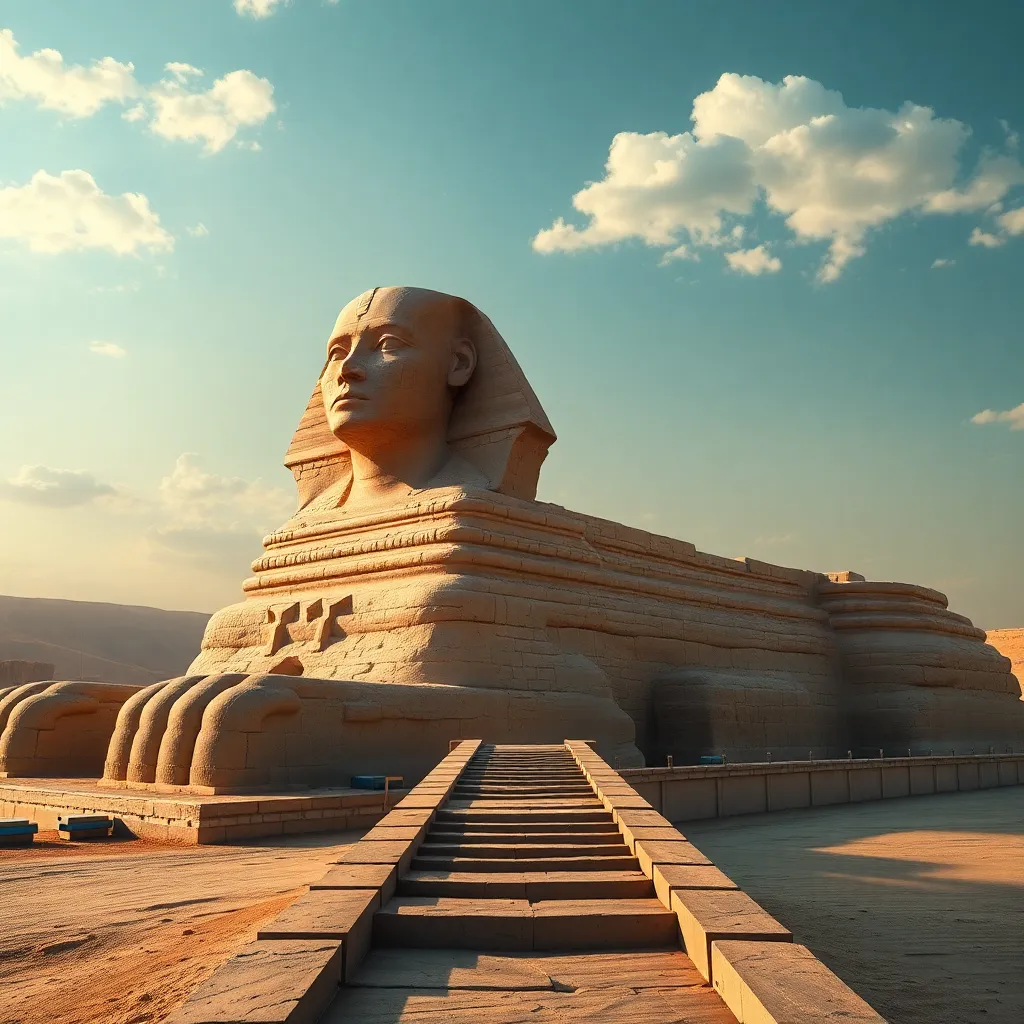The Sphinx: A Bridge Between Man and the Divine
I. Introduction
The Great Sphinx of Giza stands as one of the most iconic symbols of ancient Egypt, captivating the imagination of people for millennia. This colossal limestone statue, with the body of a lion and the head of a human, embodies the cultural and spiritual significance of the ancient Egyptian civilization. The Sphinx represents a bridge between humanity and the divine, encapsulating the beliefs and values of a society that revered both gods and pharaohs.
In ancient Egyptian culture, the Sphinx served as a protector of sacred spaces and a guardian of knowledge. Its watchful gaze over the Giza Plateau symbolizes the connection between the earthly realm and the celestial, reflecting the Egyptians’ understanding of the universe and their place within it.
II. Historical Context
The origins of the Sphinx can be traced back to the Old Kingdom of Egypt, specifically during the reign of Pharaoh Khafre (c. 2558–2532 BCE). The construction of the Sphinx is believed to have been part of a larger complex, which included the pyramids of Giza. Over the centuries, the Sphinx has undergone various restoration efforts due to natural erosion and human activity.
Key periods of worship related to the Sphinx include:
- Old Kingdom: The Sphinx was likely constructed to honor Pharaoh Khafre and serve as a guardian for his pyramid.
- Middle Kingdom: The Sphinx continued to be revered, with references in literature and art indicating its importance.
- New Kingdom: Pharaohs such as Hatshepsut and Thutmose III incorporated the Sphinx into their religious practices.
III. Architectural Marvel
The Sphinx is an architectural marvel, measuring approximately 73 meters long and 20 meters high, making it one of the largest sculptures in the world. Its face is thought to represent Pharaoh Khafre, although this has been debated among scholars. The body of the Sphinx, resembling a lion, signifies strength and power, while the human head symbolizes intelligence and leadership.
The design choices made in the construction of the Sphinx reflect deep symbolic meanings:
- The lion’s body represents royalty and courage, attributes associated with the pharaohs.
- The human head signifies wisdom and the divine aspect of kingship.
- The alignment of the Sphinx faces the rising sun, linking it to the solar deity Ra and the concept of rebirth.
IV. Mythological Connections
The Sphinx holds a significant place in Egyptian mythology, often associated with the protective qualities of the lion and the intelligence of humans. In Egyptian lore, the Sphinx is depicted as a guardian of sacred spaces, ensuring that only the worthy could enter. It is also connected to the myth of Osiris, where the Sphinx represents the cycle of life and death.
When comparing the Sphinx to other sphinx figures in global mythology, we find intriguing parallels:
- Greek Sphinx: This creature posed riddles to travelers, symbolizing knowledge and the dangers of ignorance.
- Mesopotamian Sphinx: Often depicted with a lion’s body and human head, it served as a protector of temples.
V. The Sphinx and the Pharaohs
The Sphinx has long been associated with the divine authority of the pharaohs. It was viewed as a symbol of protection, ensuring the safety of the ruler and the kingdom. Pharaohs often aligned themselves with the Sphinx to legitimize their reign and connect with the divine.
Throughout history, several pharaohs have paid homage to the Sphinx:
- Khafre: Associated with the creation of the Sphinx as a testament to his power.
- Thutmose IV: Claimed to have restored the Sphinx, linking himself to its divine protection.
VI. Interpretations Through the Ages
Over the centuries, the Sphinx has been interpreted in various ways by different cultures. Ancient Greeks, Romans, and later civilizations have all contributed to the Sphinx’s evolving mythology. In modern literature and art, the Sphinx has become a symbol of mystery and enigma.
Some notable representations of the Sphinx in contemporary culture include:
- Literature: The Sphinx appears in works by authors such as Edgar Allan Poe and H.P. Lovecraft, often symbolizing knowledge and the unknown.
- Art: Artists have drawn inspiration from the Sphinx, incorporating its imagery into paintings, sculptures, and installations.
- Film: The Sphinx has been featured in movies, representing ancient wisdom and the allure of ancient civilizations.
VII. Archaeological Discoveries
Recent archaeological discoveries have shed new light on the Sphinx and its significance. Excavations around the Giza Plateau have uncovered artifacts and structures that provide insight into the Sphinx’s purpose and the rituals associated with it.
Ongoing research continues to explore theories about the Sphinx:
- Some scholars suggest that the Sphinx may have served as a solar symbol, aligned with astronomical events.
- Others propose that it was part of a larger necropolis, emphasizing its role in the afterlife.
VIII. Conclusion
The Sphinx remains an enduring legacy of ancient Egypt, symbolizing the connection between humanity and the divine. As a guardian of knowledge and protector of sacred spaces, the Sphinx continues to inspire awe and wonder in those who encounter it. Its role in contemporary understanding of ancient beliefs highlights the importance of mythology in shaping cultural narratives.
As we reflect on the Sphinx’s significance, we recognize its timeless appeal and its ability to bridge the gap between the past and present, inviting us to explore the mysteries of the ancient world.
https://www.youtube.com/watch?v=AhuPEp4ct6U




